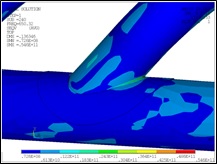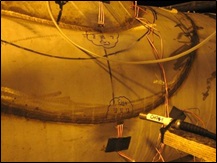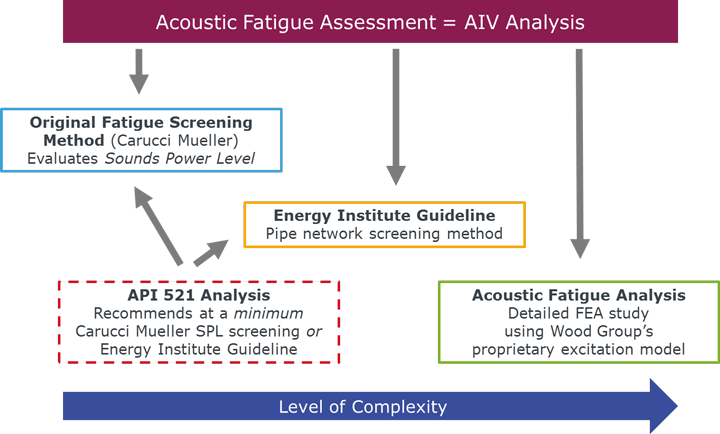Services
- Static Equipment & Structures (Piping Vibration & Fatigue)
- Acoustic Fatigue Assessment for Blowdown Systems
- Acoustic-Induced Vibration (AIV) Analysis
- Finite Element Analysis (FEA) and Computational Fluid Dynamics (CFD)
- Flow-Induced Turbulence (FIT) Analysis
- Flow-Induced Vibration (FIV) Analysis
- Multiphase and Slug Flow Analysis
- Pipe Stress Analysis
- Piping Vibration and Integrity Assessment
- Review & Design Support Services
- Small-Bore Connections (SBC) Assessment
- Structural Vibration and Dynamic Design Analysis
- Subsea Piping Vibration
- Thermal Striping
- Tube Failure Analysis
- Veridian AM
- Veridian VS
- Vibration Inspection Program
- Water Hammer Analysis
- Machinery Analysis
- Bottle Sizing Service
- Compressor Package Engineering
- Finite Element Analysis (FEA) and Computational Fluid Dynamics (CFD)
- Foundation Design and Dynamic Analysis
- Fuel Gas Compressor Piping Transient Analysis
- Lateral Vibration Analysis
- Pipe Stress Analysis
- Pulsation & Mechanical Analysis: Reciprocating Compressor
- Pulsation & Mechanical Analysis: Reciprocating Pump
- Pulsation & Mechanical Analysis: Screw Compressor
- Pump RCF Analysis
- Review & Design Support Services
- Shell Transverse Acoustical (STA) Analysis
- Skid Design and Analysis
- Surge Control Design for Centrifugal Compressor Systems
- Torsional Vibration Analysis (TVA)
- Field Engineering & Troubleshooting
- Finite Element Analysis (FEA) and Computational Fluid Dynamics (CFD)
- Human Vibration
- Motion Amplification Vibration Analysis
- Noise Troubleshooting
- Performance Assessment (Thermodynamic)
- PostPro – field data processing and analysis
- Structural Vibration Troubleshooting
- Thermal Striping
- Troubleshooting, Root Cause Analysis (RCA)
- Veridian iDAC
- Vibration Inspection Program
Acoustic Fatigue Assessment for Blowdown Systems
API Std 521 for pressure relief and blowdown valves
Contents [ hide ]
1 What is acoustic fatigue?
During operation of choked-flow gas valves significant levels of high-frequency noise can be generated, leading to excessive vibration and ultimately, to an acoustic fatigue failure of the associated downstream pipework.
Typical sources of such noise include:
- Pressure relief and safety valves
- Blowdown (orifice plate) valves
- Pressure control valves
- Choke valves
- Gas compressor recycle and anti-surge valves
- Hot-gas bypass valves
The consequences of an acoustic fatigue failure (also known as acoustic-induced vibration or AIV) are severe, from both a safety standpoint (gas explosion, sour gas release) and production viewpoint (loss of flare or gas compression system).
2 API 521 requirements
API Standard 521 (6th edition, January 2014) requires that “the potential for acoustic fatigue” be evaluated through one of several different methods, with the Energy Institute “Guidelines for the avoidance of vibration induced fatigue failure in process pipework”, in particular being widely employed. This risk-based screening methodology has been used globally for both new design and operational assets.
3 Our expertise
Engineers in the VDN group have significant experience of carrying out acoustic fatigue assessments for:
- Greenfield and brownfield facilities
- Onshore and offshore facilities
- Upstream, midstream and downstream (refineries and gas transmission pipelines) assets
- Liquefied natural gas plants – EPC stage or operational
4 Design stage acoustic fatigue assessment
At the design stage, we ill work with the project team to develop a piping design sufficiently robust that the risk of an acoustic fatigue failure is minimized. The approach is a three-step methodology, based on the industry best practice Energy Institute Guidelines, which members of the VDN team co-authored.
Recommended three-phase methodology:
 Phase 1: Identification of valves or valve groups which generate sufficient noise energy to be of potential acoustic fatigue concern.
Phase 1: Identification of valves or valve groups which generate sufficient noise energy to be of potential acoustic fatigue concern.- Phase 2: Identification of piping connections at significant risk of acoustic fatigue failure, based on the incident noise level and their detailed design.
- Phase 3: Identification and evaluation of appropriate noise and vibration control measures, to reduce the risk of acoustic fatigue failures to an acceptable level. This could take the form of simple design changes or detailed finite element analysis to predict the acoustic fatigue life more accurately.
5 Operational stage acoustic fatigue assessment
For an operational plant, the VDN group can provide the following technical services:
 If required, site measurements on the pipework identified as being of concern, for example, vibration, noise and dynamic strain pressure pulsation, using, multi-channel, intrinsically safe monitoring systems.
If required, site measurements on the pipework identified as being of concern, for example, vibration, noise and dynamic strain pressure pulsation, using, multi-channel, intrinsically safe monitoring systems.- Screening assessments as per the three-phase methodology outlined for the design stage.
- Detailed finite element analysis, where an initial study has already been conducted or a problem has been identified. This can either predict piping stress levels or, if field data is available, accurately predict acoustic fatigue lives and evaluate the effectiveness of long-term modifications.
As part of Wood, the VDN team also has access to other specialist engineering services such as CFD, materials and production chemistry.

6 Research and joint industry projects (JIPs)
Wood is participating in an Energy Institute joint industry project (JIP) addressing AIV. The current phase seeks to provide measurement data to give insights as to the response of different piping configurations to AIV, and quantify the effectiveness of various mitigation measures.

Test work is being undertaken at the Emerson Fisher flow labs in Marshalltown under high-pressure relief and blowdown conditions. Wood is providing data analysis capability of the acquired dynamic strain, acceleration and dynamic pressure data as part of our in-kind contribution to this applied research program.
BP, Chevron, ConocoPhillips and Nexen are the principal operating companies involved, with other contributors including Bechtel, Chiyoda, Emerson Process Management, KBR, Petrofac and Xodus.
7 Inquiries
For further information, or to discuss your acoustic fatigue concerns, email us at info.vdn@woodplc.com.
Related Information
Related Services
- ACOUSTIC-INDUCED VIBRATION (AIV) ANALYSIS
- Piping Vibration and Integrity Assessment (Energy Institute Study, 2008, AVIFF)
- Pipe Stress Analysis
- Flow-Induced Turbulence (FIT) Analysis
- Flow-Induced Vibration (FIV) Analysis
Keywords
- API 521
- AIV Acoustic-Induced Vibration
- Piping Fatigue Assessment
- Acoustic Fatigue
More Info
Webinar: Shake, rattle and grow (2022 update) • Webinar: Controlling dynamic flexibility • Webinar: Piping and tubing vibration anomaly mgmt • Multi-channel vibration measurements • Vibration-induced fatigue management (Offshore Magazine) • Webinar: Shake, rattle and grow I (2022 update) • Avoiding vibration-induced fatigue failure • Examples of Piping Vibration (Video) • Pipe Support Stiffness, GMRC Project • Transient Conditions on Small-Bore Piping • Piping Vibration Design Considerations • Tips for Managing a Successful Vibration Project • Piping Vibration Examples • An Integrated Approach to Manage Vibration Risks •
Free webinar
Learn how to solve complex vibration problems with advanced troubleshooting techniques to keep your facility running smoothly, with minimal downtime. Watch now





